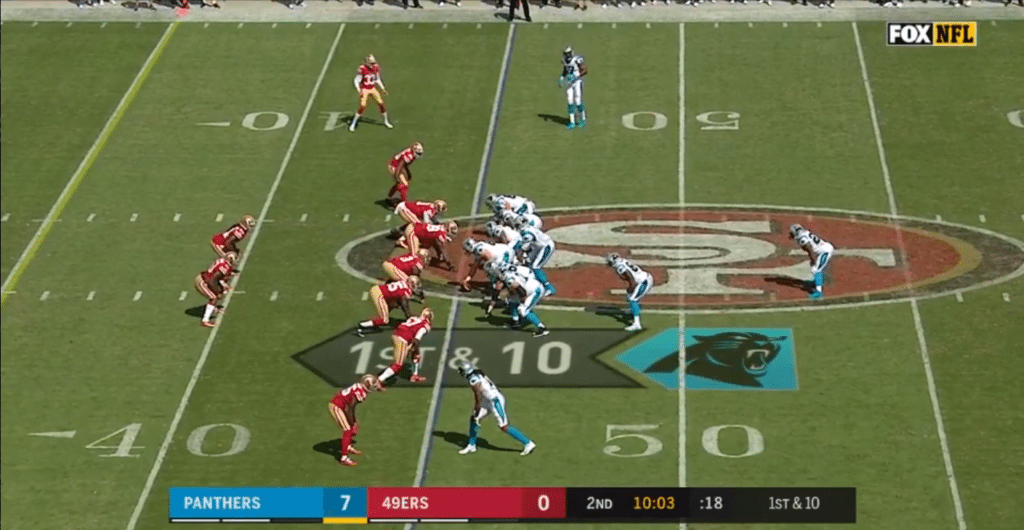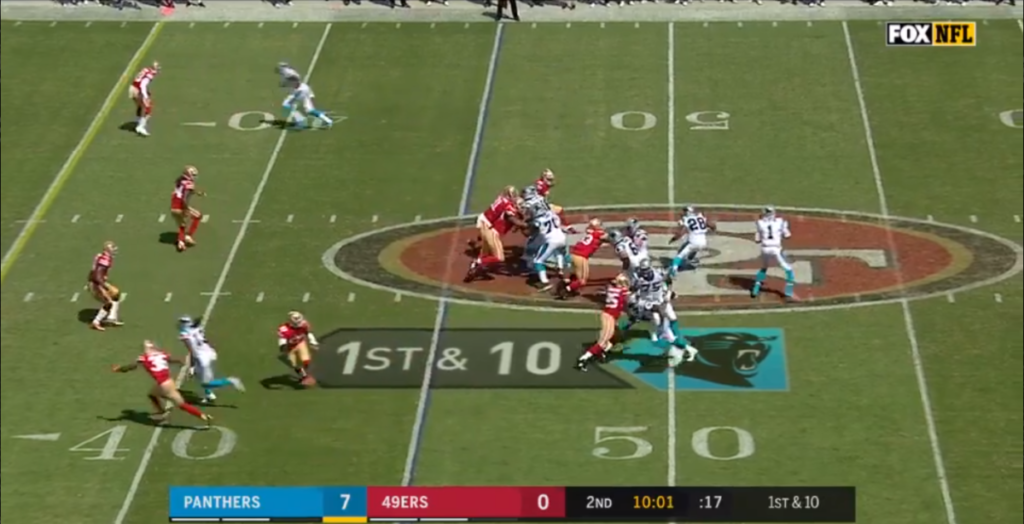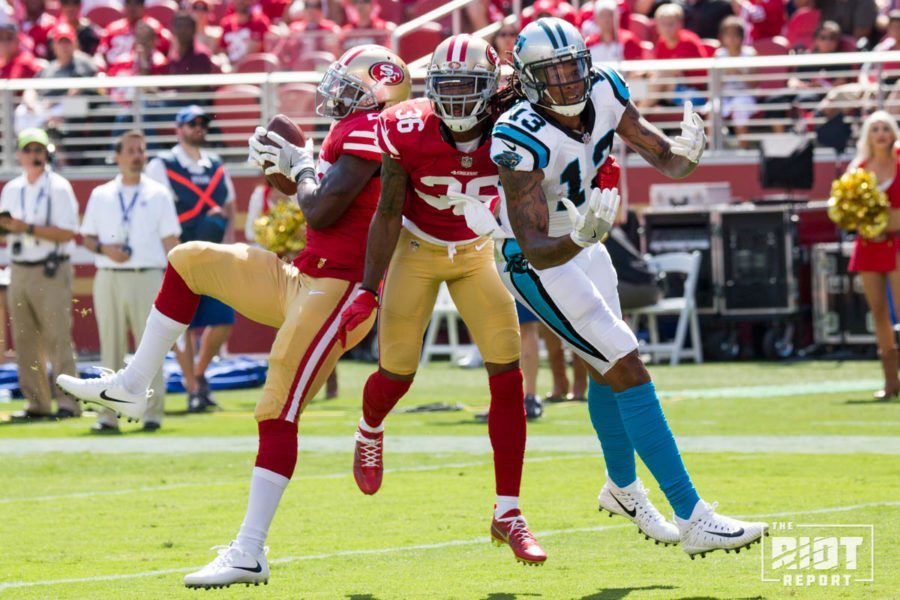While it wasn’t the prettiest performance, the Panthers’ 23-3 victory over the 49ers on Sunday will show up the same as any others when it comes to deciding playoff spots at the end of the regular season. Similarly, the interception Cam Newton threw in the second quarter will show up just the same as any others he might throw this season. However, this one play exemplified almost everything that went wrong with the Panthers’ offense last season and merits further examination.
The Play That Should Never Have Been
While Shula has been far from perfect as an offensive coordinator, one of his strengths has been a feel for when to call what play. He showed this savvy play-calling with the nice screen to Stewart for the touchdown inside the red zone, but his touch deserted him on the play in question. The Panthers had been struggling to run the ball early in the game, averaging under 3.4 yards per carry, and so calling a play-action pass on first down seems to be an odd choice.
Even if the Panthers had been running the ball well, once Cam saw the defensive formation there should have been little hesitation in changing the play.

With two extra blockers for the Panthers (Olsen at TE and Dickson at FB), the 49ers bring two outside defenders down to the line of scrimmage with two deeper-set inside linebackers and the one deep safety. This formation is effectively daring the Panthers to try and throw the ball, quite possibly due to Newton’s struggles with rust early in the game. To show just how little the 49ers were buying the play action, look how the linebackers react prior to the supposed hand-off:
This is not the reaction that play-action plays are designed to create, to put it mildly. Whether Cam misread the defense or whether Shula only called in play-action is impossible to tell without inside knowledge, but this play needs to be checked out of, preferably audibled to a quick pass that capitalizes on the crowding of the 49ers’ front seven.
Designed to Fail
Even if the Panthers had run this play against a more suitable defense, there are issues with the play itself. Passing plays are composed of the protection and the routes. First, let’s examine the protection.
Given that it is a play action pass, Olsen, Stewart and Dickson have to remain in initially in order to sell the run fake. However, once the quarterback has faked the run and turns to read the field, there is no benefit to have the extra blockers. Dickson does release well but Stewart hesitates and Olsen remains in to block throughout. There are times when Greg Olsen should be used in pass protection, but a 1st-and-10 from the 45 isn’t one of them. When arguably the best receiving tight end in the NFL is used as a pass protector, the defense gets an immediate advantage. Rather than the two central linebackers being forced to deal with Olsen running over the middle, they are able to drop deeper up the field.
As they are able to take away the intermediate middle of the field, the corners don’t need to worry about what’s inside of them and the deep safety is able to focus inside the numbers.Likewise, unless Newton is in immediate risk of being hit, Stewart needs to attack the flat as soon as the hand-off is faked in order to give Newton a short YAC option. These two potential receivers are not available for Newton, so he is left to choose from the three receivers he does have, who are being covered by the remaining seven defenders.
What is so frustrating is that a major point of play-action passes is that they are able to open up the intermediate middle and the flats by forcing defenders towards the tackle box, and these are the two areas that the Panthers aren’t attacking by keeping Stewart and Olsen in to block. A good example of how this can be done well came later in the game, after the Panthers had established more of a run game and against a more run-focused defense:
The route combination on the interception play is actually not without logic, it’s just that with only three receivers, the play is very simple for the defense to effectively counter. The two deep routes by Benjamin and Funchess force three defenders to cover them, leaving a man advantage for the offense. The 49ers are playing zone underneath which, given time, Cam should be able to pick apart.
Bad Attitude
While much of the criticism for this play so far has focused on Shula, the ultimate reason for the interception falls solely on Newton. From when he turns around after the run fake he should be able to recognize the defense and to hit Dickson underneath.

It is clear that the defense hasn’t bitten on the play-fake as the two linebackers are dropping deep to take away the intermediate middle and the deep-three are likely to take away any deep pass. At this point, Newton needs to learn to be happy to take what the defense is giving him, namely the underneath route to Dickson.
While a lot of the issues last season can be laid at the door of the offensive line, Newton’s attempts to generate big plays even when such plays are taken away, was an issue. This attitude change is what separates Tom Brady from Brett Favre; the greatest from the most talented. When shown from other angles, it is clear that Newton misreads this play as Benjamin does not have separation:
While the safety cannot take away both deep passes at once, the ball takes so long to get there that Tartt makes both passes risky, even if there hadn’t been good coverage by either corner. What should also be noted is the Panthers’ personnel decisions on this play. Neither Funchess nor Benjamin are especially fast (Benjamin could even be said to be slow when compared to other NFL wide recievers) and so neither gain little vertical separation.
Given that the Panthers invested significant draft picks and cap space in getting faster on offense, it is surprising that none of those players are on the field on a play like this. The personnel grouping on the above play might make sense in the red zone, but the lack of speed is limiting elsewhere on the field.
Tartt’s interception is impressive and this throw will not usually end in an interception, but it will rarely lead to a touchdown. As described above, this play went wrong at several steps all of which speak to a persistent problem with the Panthers’ offense from a season ago. Going forward, the Panthers need to avoid making such mistakes if they are going to challenge some of the more talented teams around the league.



